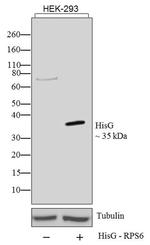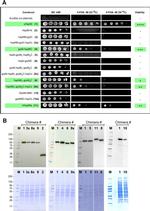Search Thermo Fisher Scientific
图: 1 / 3
HisG Epitope Tag Antibody (R941-25) in WB



产品信息
R941-25
种属反应
已发表种属
宿主/亚型
分类
类型
抗原
偶联物
形式
纯化类型
保存液
内含物
保存条件
RRID
产品详细信息
NOTE: R941-25 was previously sold under product #46-1009. When re-ordering, please use #R941-25.
This antibody is designed to specifically detect recombinant proteins containing the seven amino acid 6xHis-Gly epitope. This epitope is present in many expression vectors encoding an N-terminal 6xHis tag. The HisG antibody recognizes the following sequence: -His-His-His-His-His-His-Gly and can be used to detect expression of fusion proteins from bacterial, insect, and mammalian cells.
Anti-HisG-HRP Antibody was prepared by crosslinking the Anti-HisG Antibody with horseradish peroxidase using glutaraldehyde. It has been tested in immunoblotting and ELISA procedures. It was tested against purified Positope™ control protein (5 ng). The Positope™ control protein is a 53 kDa recombinant protein that contains seven epitope tags, including His(C-term), HisG, c-Myc, and V5. Low background was observed using chemiluminescent or alkaline phosphatase reagents for detection. In western blot experiments with purified protein, 50 ng (for Anti-HisG-HRP Antibody) of the Positope protein gave a detectable signal.
For western blot, dilute in PBS containing 0.05% Tween-20 and 5% nonfat, dry milk (PBSTM). Using chemiluminescence as the detection method, no cross-reactivity has been observed in bacterial lysates. In mammalian lysates, a few cross-reactive proteins have been observed upon overexposure of blots. If you use alkaline phosphatase-conjugated secondary antibody, do not use PBS. Phosphate inhibits alkaline phosphatase. Use Tris-Buffered Saline (TBS) instead. Be sure to wash the western blot or microtiter wells before adding the horseradish peroxidase-conjugated secondary antibody. Azide will inhibit HRP activity. This product contains enough material for 25 western blots; assumes 10 mL buffer per western blot.
靶标信息
Epitope tags provide a method to localize gene products in a variety of cell types, study the topology of proteins and protein complexes, identify associated proteins, and characterize newly identified, low abundance or poorly immunogenic proteins when protein specific antibodies are not available. Expression of recombinant proteins in E. coli as a fusion protein with neighboring histidine residues is one of the most popular methods of epitope tags. The affinity of the histidine-tag motif to Ni2+ by chelation is strong and selective enough to enable purification of the protein to homogeneity by affinity chromatography on a Ni2+-NTA adsorbent. HisG antibodies allow detection of recombinant proteins containing a polyhistidine sequence: His-His-His-His-His-His-Gly (6xHis-Gly epitope). HisG antibodies can be used to detect expression of fusion proteins from bacterial, insect, and mammalian cells.
仅用于科研。不用于诊断过程。未经明确授权不得转售。
生物信息学
蛋白别名: 6xHis-Gly; 6xHis-Glycine; His G; His Tag; Histidine Tag



